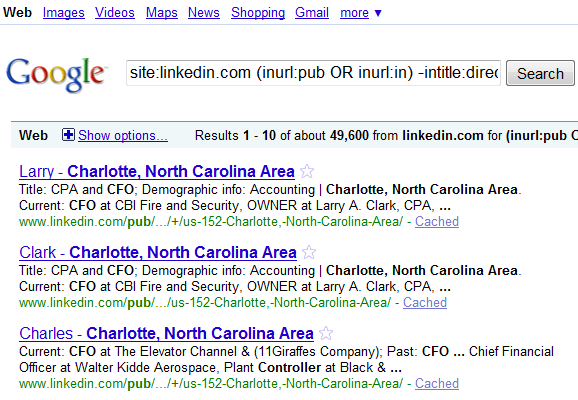 When it comes to searching LinkedIn using Internet search engines such as Google or Yahoo, there are many different ways to construct your search string (“X-Ray” or otherwise) and get results.
When it comes to searching LinkedIn using Internet search engines such as Google or Yahoo, there are many different ways to construct your search string (“X-Ray” or otherwise) and get results.
Ultimately, the goal of any good sourcer or recruiter is to find all of the best available potential candidates that a particular source has to offer.
A short while ago, Gary Cozin sent me a link to an article recommending to “forget complex Boolean strings” when searching LinkedIn using Internet search engines.
I read the article and appreciated the advice to go with the easier, simpler, more elegant search solutions, as well as the suggestion to try “Public profile powered by.” I had never thought of taking that approach – but more on that later.
First, a Little X-Ray History
If you do some research online, you’ll find that the LinkedIn X-Ray search strings that experts in the industry were recommending for years looked something like this:
site:www.linkedin.com intitle:linkedin “current * test manager” -intitle:answers -intitle:updated -intitle:blog -intitle:directory -inurl:jobs -inurl:megite.com -intitle:profile -inurl:jobid
That string has 8 exclusions – effective, but far from simple and elegant.
A while ago, I came up with and recommended a simpler, more elegant approach to the LinkedIn X-Ray search that focused on inclusion rather than a long list of exclusions by specifically targeting profiles using (inurl:in OR inurl:pub), which allowed me to get away with only using 1 exclusion: -intitle:directory.
This approach yielded a simple, short and effective “core” X-Ray syntax of:
site:linkedin.com (inurl:in OR inurl:pub) -intitle:directory
Short and sexy, right?
And Then….
Sometime in April, many people (including myself) noticed that when running a “standard” LinkedIn X-Ray string with Google, that rather than returning the familiar results of individual LinkedIn profiles, results would come back organized by first or last name. Additionally, many noticed that jobs would come up at the top of the results.

I checked into the matter and suggested to add a couple of exclusions, in the form of -inurl:dir -inurl:jobs to get back to the desired results of individual LinkedIn profiles.
That worked, but my simple, short and effective “core” X-Ray syntax of site:linkedin.com (inurl:in OR inurl:pub) -intitle:directory got a little longer and uglier with the addition of -inurl:dir -inurl:jobs. I wasn’t particularly happy about that, but it seemed the only way to get rid of the new garbage, non-individual profile, results.
However, it’s still shorter and more elegant than the X-Rays of yore with massive multiple exclusions.
A New Approach
Going back to the idea of using “Public profile powered by” when using an Internet search engine to look for public LinkedIn profiles – I was intrigued by the concept of dropping the X-Ray string altogether and targeting a phrase that is found on every public LinkedIn profile.
It simply never occurred to me to try it, and I sincerely appreciate the novel approach.
Gary Cozin asked me what I thought of the idea. My first impression was that I found it interesting and I respected the mini-breakthrough in thought that produced it, but I told Gary that I needed to do some testing to be able to tell if it is as effective as other methods of searching for LinkedIn profiles on the web.
So I Performed Some Tests
First – remember that when doing any comparison testing of Internet searches , you have to configure them so that they return a manageable number of results – ideally a few hundred or less. Anything higher than that, and you can get into “estimate” territory.
Here is a simple comparison of the “Public profile powered by” vs. a “standard” X-Ray search on Google.
First up – the “Public profile powered by:”
Microsoft “Public profile powered by” “greater atlanta area” “software engineer” java
That yields 7 results. You have to click on “repeat the search with the omitted results included” to get to 103 results. If you click through to page 10 of the results, for some reason there are only really 100. But you get the point.
Next we have a “standard” X-Ray search with the same criteria:
That yields 287 results. But not really (thanks Google!). If you click through the results pages, you’ll be stopped on page 24 for a total of 232 results.
In that one search comparison, there is a difference of over 100 results, and I didn’t see any duplicates or bad results from my sampling with the “standard” X-Ray.
As a side note, searching for the word “Microsoft” using Google to search LinkedIn will get you many results with hits of common Microsoft software (e.g., Office), as well as the abbreviation “MS,” which even gets hits of Master’s degrees (I found at least 1 instance of this). If you want to force Google to only return the word “Microsoft,” you have to use quotes or the plus (+) sign.
So What Causes the Difference in Results?
That’s a great question. The phrase “Public profile powered by” does seem to be on every public LinkedIn profile, so why would searching for it find fewer results, let alone produce any difference?
Honestly, I am not really sure. Irina Shamaeva has some ideas as to what could cause the difference in search results.
Maybe some people at Google could shed some light on the matter? <not holding my breath>
The Bottom Line
Regardless of why Google isn’t finding all of the available public LinkedIn profiles by searching for “Public profile powered by,” the bottom line is that the “standard” (inelegant and longer) X-Ray string finds more.
Even if the results gap wasn’t as dramatically large as I found in that one test scenario (I did find some larger and smaller results variations), the fact that the results are different AT ALL is what makes me concerned. I don’t like to miss any results.
To make sure you don’t miss any available search results, I strongly encourage you to do your own testing of the various ways to search LinkedIn using an Internet search engine using relevant search terms for whatever you typically look for.
While I love the simplicity and appreciate the approach of searching for public LinkedIn profiles by not having to use the lengthy site:linkedin.com (inurl:in OR inurl:pub) -intitle:directory -inurl:dir -inurl:jobs, I would never abandon the uglier, longer string at the expense of missing any available search results (not even 1!).
Some More Google Fun
Taking the approach of targeting a phrase common to every public LinkedIn profile a step further, I also experimented with searching for the phrases “Create a public profile” and “professionals already on LinkedIn.”


Here’s a comparison:
Microsoft “Public profile powered by” “greater atlanta area” “software engineer” java
Microsoft “Create a public profile” “greater atlanta area” “software engineer” java
Microsoft “professionals already on LinkedIn” “greater atlanta area” “software engineer” java
Approximately 103, 124, and 150 results respectively.
Did that get your attention?
Why are they different at all, when all three phrases appear on all public LinkedIn profiles? I don’t have the answer.
If Google allows you to click on a cached result without apologizing for thinking you’re not human (am I bitter?), you can clearly see Google indexes the other phrases:

So What about Yahoo and Bing?
Everyone has their search engine preferences, and my first choice has always been Google. However, with the recent changes in LinkedIn X-Ray search results as well as the issue of Google thinking everyone has suddenly become a malicious bot sending automated queries to their servers, I’m looking more at Yahoo and Bing.
Interestingly though, as Irina reminded me recently, Yahoo is giving up their search technology and in the near future will be using Microsoft’s. So technically – Yahoo search may not yield any different results than Bing in the future. Enjoy the results while you can. :-)
Anyhoo…Yahoo does currently seem to do a much better job of searching public LinkedIn profiles with the phrase of “Public profile powered by:”
Microsoft “Public profile powered by” “greater atlanta area” “software engineer” java
416 results! But don’t get too excited – if you click through to the end/last page (to keep Yahoo honest), you end up with 208.
Which is less than the 232 we found using a “standard” X-Ray string on Google.
Interestingly, Yahoo also does a better job of getting consistent results when using other phrases such as “professionals already on LinkedIn” (210 results, if you were curious).
What about Bing? Bing apparently doesn’t like searches like Microsoft “Public profile powered by” “greater atlanta area” “software engineer” java.
Final Thoughts
There is always more than one way to run a search, and there is no single “right way” to find people. Use multiple approaches, and always test them to understand and appreciate differences.
When searching any source, your goal as a sourcer or recruiter is to find all of the best candidates the source has to offer. Finding some people isn’t enough.
Regarding search string length when X-Ray searching LinkedIn – if you’re worried about the 32 word search limit that Google imposes, I’d argue you’re not taking into account that a large percentage of people with LinkedIn profiles don’t even flesh them out with (m)any keywords.
Always appreciate, understand and respect how the non-sourcer / recruiter / HR professional uses LinkedIn…most don’t use it as a full-blown resume.
So if you’re loading up your Google/LinkedIn strings with anywhere close to 32 words (e.g., site:linkedin.com (inurl:in OR inurl:pub) -intitle:directory -inurl:dir -inurl:jobs “greater atlanta area” “software engineer” java unix oracle linux application design develop C++ MySql J2EE Lead Senior SQL data javascript hibernate blah blah blah…), you are actually making it impossible to find all of the qualified candidates on LinkedIn.
Contemplate this on the tree of woe.
:-)